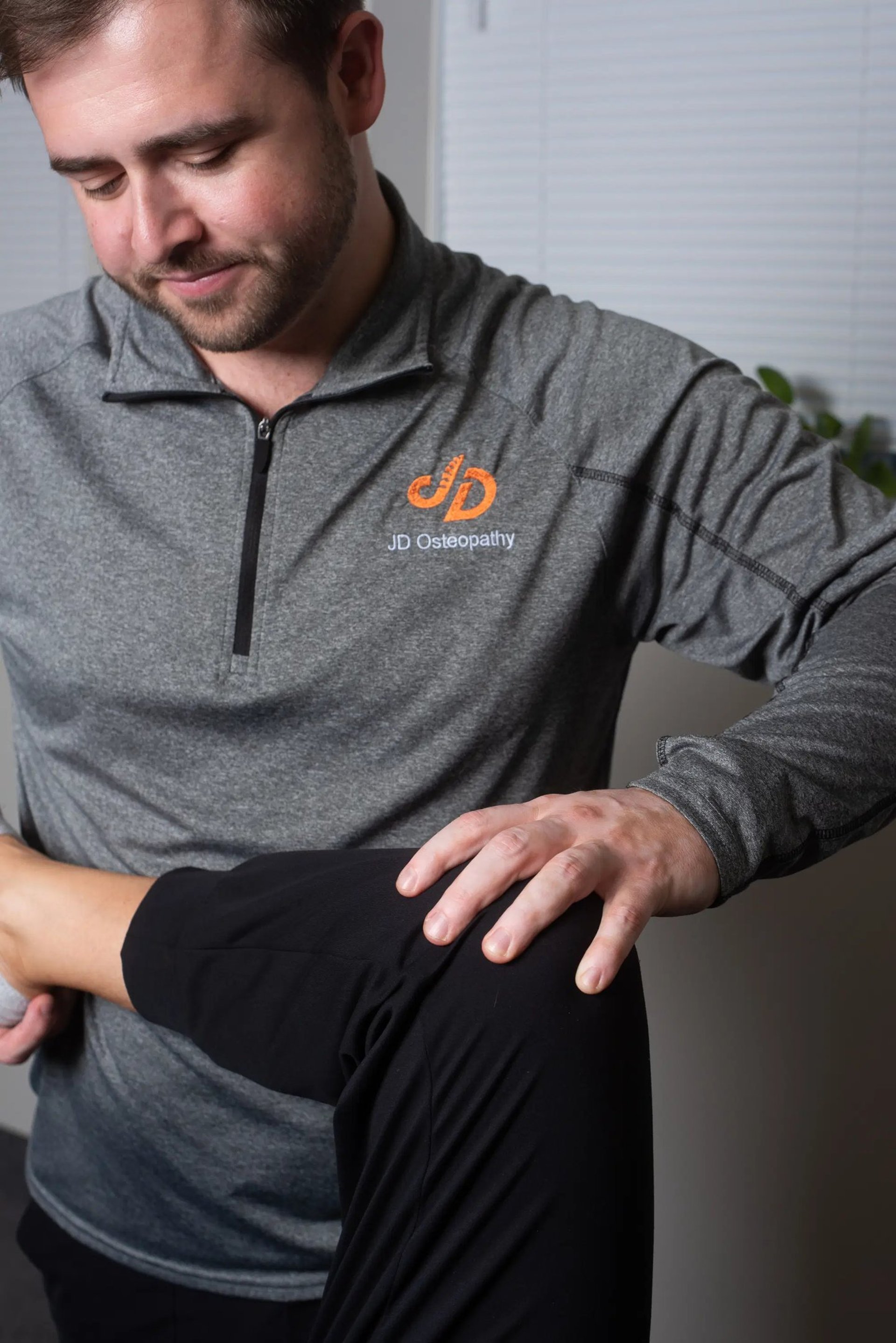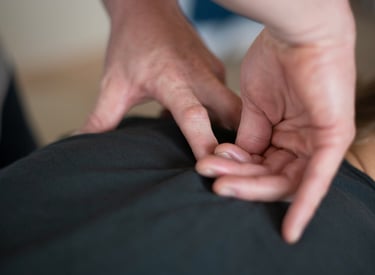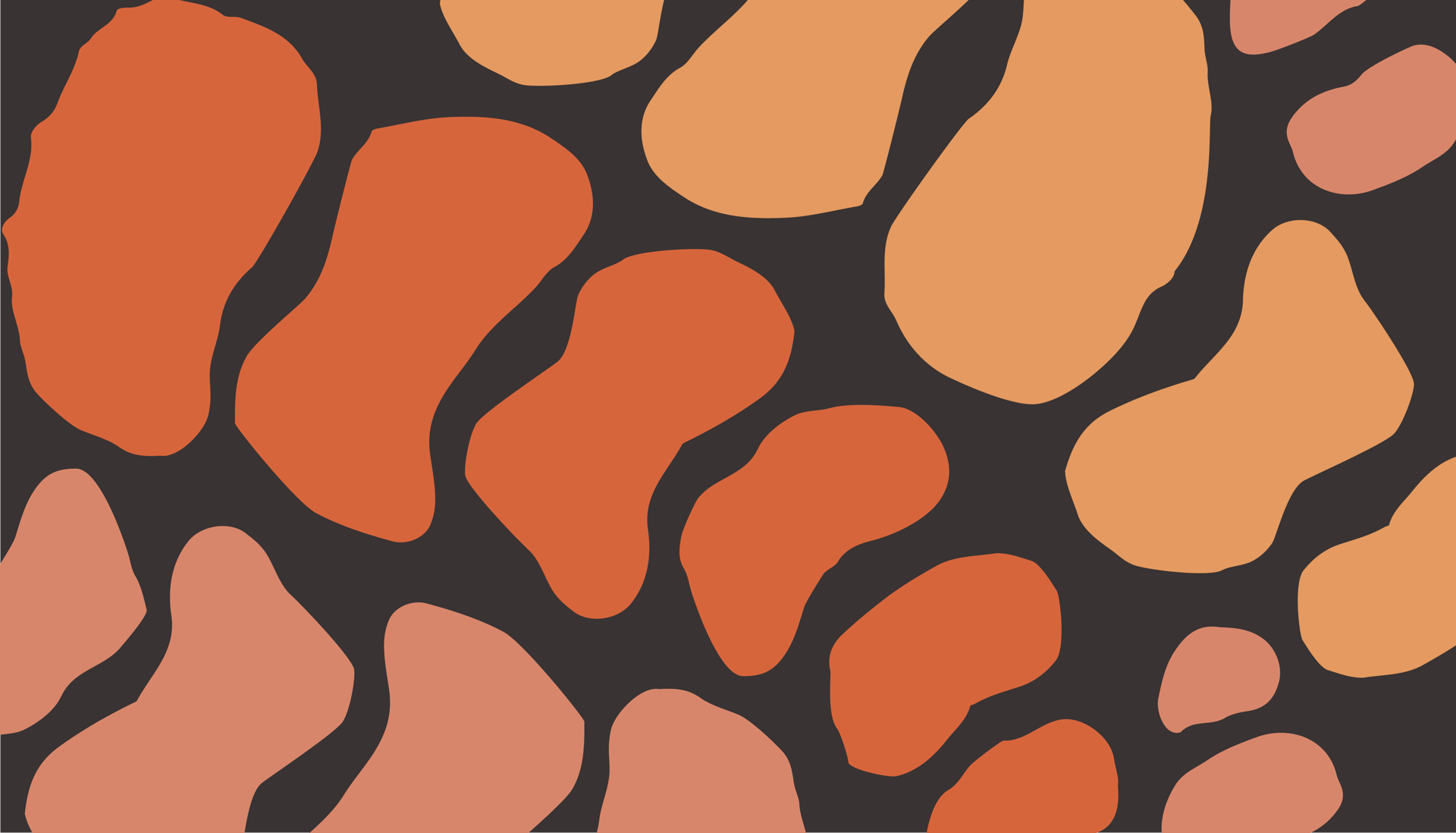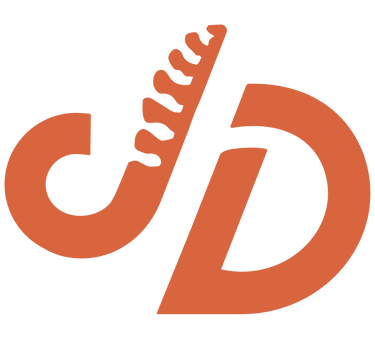
YOUR BODY
DESERVES OSTEOPATHY
About
JD Osteopathy
With two offices in Mississauga and Burlington, our approach is focused on delivering personalized osteopathic treatment plans that get results—whether you're recovering from injury, managing pain, or optimizing performance.
Our goal is to ensure you walk out better than when you came in and allow your body to have the resources and freedom to recover on your own.
Experience the difference of care that doesn't just make you feel better—it makes you function better!
We want to make sure you leave the appointment feeling more empowered and with a better understanding of what’s going on. At JD Osteopathy, we’re here for you.


Two locations to serve you better
5025 Orbitor Dr Building 1-101,
Mississauga, ON L4W 4Y5
3141 Walkers Line,
Burlington, ON L7M 0E1

What can osteopathy help with?
Osteopathy can help with a wide range of conditions, particularly those affecting the musculoskeletal system, including back and neck pain, headaches, sports injuries, and even digestive issues.
Back and neck pain
Joint pain and stiffness
Sciatica
Headaches
Sports injuries
Digestive issues
Arthritis symptoms
Muscle tension
Pregnancy-related discomfort
Infant-related conditions
Posture problems
Recovery from injuries
Hear from our happy patients

What can osteopathy help with?
Osteopathy can help with a wide range of conditions, particularly those affecting the musculoskeletal system, including back and neck pain, headaches, sports injuries, and even digestive issues.
Frequently asked questions
What is manual osteopathy?
Manual Osteopathy or just “osteopathy” is a holistic approach to manual therapy, focused on the entire body, aiming to find causes of problems in the body and restoring the motion in those areas to allow the body to function better. The principles of osteopathy are founded by Dr. Andrew Taylor Still that focuses on anatomy (aka the body’s structure) to improve the body’s movement (aka the physiology function, snd reduce symptoms such as pain, stiffness and other stresses in the body.) It's a form of manual treatment that aims to restore the communication between structures in the body. Unlike certain other treatments that can get lost in solely focusing on specific site of the symptoms, osteopathic care focuses on finding the source of the problem with the whole body in mind.
What’s the difference between osteopathy vs physiotherapy or other manual therapies?
Osteopathy differs from physiotherapy and chiropractic in its whole-body approach. Osteopathy emphasizes a holistic view, aiming to treat the body as an interconnected system. This involves using manual techniques such as stretching, gentle pressure, and resistance to improve mobility and relieve tension. In contrast, physiotherapy often targets specific areas impacted by injury or illness, employing methods like exercises, electrotherapy, and education to aid in rehabilitation. Both practices aim for pain relief and enhanced function, but your choice may depend on the nature of your issue and personal preferences. Whether seeking osteopathy or physiotherapy in Mississauga, understanding their differences between osteo vs. physio helps in making an informed healthcare decision.. If you’d like to learn more in depth, check out our blog post covering this very topic.
Can osteopathy help with postpartum recovery and infants?
Yes, osteopathy can aid postpartum recovery by alleviating back pain, pelvic discomfort, and muscle tension. Each treatment session is tailored, taking into account medical history and health history, ensuring that care is highly personalized and not obsessed with symptoms but the anatomy involved with creating those abnormal signals.
Infants and young individuals can greatly benefit from osteopathy, as it offers a gentle and non-invasive approach to enhancing health and development. In Mississauga, parents are increasingly turning to osteopathy to address common childhood issues such as colic, digestive troubles, and sleep disturbances. By focusing on the whole body rather than isolated symptoms, osteopathy helps to balance the musculoskeletal system and improve overall bodily functions. This holistic care can encourage healthy growth patterns, boost the immune system, and promote better sleep, providing a solid foundation for lifelong well-being. Parents often appreciate the therapeutic and preventive benefits that osteopathy can offer their children during these formative years.
Infants and young individuals can greatly benefit from osteopathy, as it offers a gentle and non-invasive approach to enhancing health and development. In Mississauga, parents are increasingly turning to osteopathy to address common childhood issues such as colic, digestive troubles, and sleep disturbances. By focusing on the whole body rather than isolated symptoms, osteopathy helps to balance the musculoskeletal system and improve overall bodily functions. This holistic care can encourage healthy growth patterns, boost the immune system, and promote better sleep, providing a solid foundation for lifelong well-being. Parents often appreciate the therapeutic and preventive benefits that osteopathy can offer their children during these formative years..
Is osteopathy covered by insurance?
A common question is: "Is osteopathy covered by insurance?" Generally, many insurance providers do offer coverage for osteopathic care, but it's important to check with your specific plan as coverage can vary significantly.
Although our locations in Mississauga and Burlington do not offer direct-billing services at this moment, we immediately provide an invoice & receipt digitally that includes a pdf document that can be submitted to your insurance/health benefits provider.
Checklist Before Your Visit:
Verify if your insurance plan covers osteopathic treatment.
Understand what specific osteopathic services are covered.
Check on the need for a referral from a doctor, which some insurance providers might require.
By covering these bases, you can better prepare for a seamless, stress-free osteopathic care experience.
Are osteopaths qualified healthcare professionals?
Not all Osteopathic education in Ontario is equal. The highest quality education is from a Type 1 school which meets and exceeds international standards of 4200 hours of program education, including 1000 hours of supervised clinical practice & training. Osteopathic education in Ontario should be designed with both practical and critical components. Key elements of the curriculum include joint mobilizations, the entire body assessment, and osteopathic manual techniques that adhere to osteopathic principles.
Both osteopathic manual practitioners at JD Osteopathy received their postgraduate education at the Canadian Academy of Osteopathy, obtaining the Master in practice of Osteopathic Manipulative Sciences (M.OMSc.) Click here to find out more about our osteopathic practitioners. This advanced training emphasizes a more profound understanding of osteopathic principles and ensures practitioners are well-equipped to provide optimal health care.
Summary of Key Qualifications:
4-year full-time osteopathy program
Minimum 4,200 hours in comprehensive in-person education
1,000 hours supervised clinical training & practice in a dedicated & insured clinical environment
Practical skills in joint and soft-tissue manipulation, patient care, ethics and consent
Proud Members of the Ontarios Osteopathic Association (OOA) and OST-CAN.
This robust education framework prepares practitioners to offer effective treatment and personalized care, improving the quality of life for their patients.
How can I prepare for an osteopathy appointment?
When visiting an osteopath, wearing the right clothing can significantly enhance your comfort and the osteopath’s ability to perform an accurate assessment. Choosing loose, lightweight clothing is generally recommended as it allows for ease of movement during the physical evaluation and treatment sessions. A shirt or flexible top is recommended for your comfort that does not restrict your motion . This attire facilitates a thorough examination of body posture and range of motion, which are critical components of osteopathic assessment.
During your visit, the osteopath will likely perform several physical assessments that require you to move comfortably. Clothing such as loose pants or shorts will not restrict movement and will help the manual practitioner evaluate your joint mobilization capabilities more efficiently. Remember, the goal of this attire is to allow the osteopath to assess any underlying issues contributing to chronic pain or mobility restrictions. Therefore, focusing on comfort and accessibility is key to a successful first appointment.
In summary: Avoid tight or restrictive clothes like dress pants or jeans and do wear comfortable clothing that allows the practitioner to be able to move your arms, legs and the rest of your body around, without you feeling uncomfortable. In addition, for sanitary reasons, please remember to wear socks to your appointment.
How many sessions will I need?
When considering osteopathic treatment, understanding the duration and frequency of sessions is crucial for setting expectations and planning. Typically, an initial osteopathy session may be up to 45 minutes. This longer session allows the osteopath to gather detailed information about your medical history and conduct a thorough assessment of your condition. In addition, this allows for discussion of expectations and other questions you may have about osteopathy.
Follow-up sessions are generally shorter, often lasting around 20-30 minutes. The frequency and total number of sessions needed vary based on individual needs, the severity of the condition, and the body's response to treatment.
Generally, we do not know the exact number of appointments but many patients experience relief after even one appointment. Although that’s not always the case (we’re working on it), we typically suggest 4-5 treatments that are spread out between weeks and increase in duration between appointments as you improve. This gives us enough time to really get through the issues involved.
A typical course may involve weekly sessions at the start, gradually tapering off as improvement is observed. For chronic conditions or complicated issues, a more extended treatment plan might be required.
Factors Influencing Number of Sessions:
Type and severity of injury or condition
Personal health history
Response to initial treatment
Goals for treatment (e.g., pain relief, injury prevention)
By tailoring a treatment plan to each individual's needs, osteopathic care in Mississauga and Burlington aims to improve quality of life and achieve optimal health outcomes. Always consult with your osteopath to understand your specific treatment pathway.
Is osteopathic treatment painful?
With any type of treatment or manual manipulation, there is always an inherent risk but with osteopathy, we do our best to limit the dangers by going slow and with controlled movements. We work with your body not against it to fix the restriction of motion through the body. During your treatment, our intention is not to force the change using force, nor do we use intense techniques like high velocity, low amplitude thrusts as you would typically associate with a classic chiropractic adjustment.
To quote the founder of Osteopathy, Dr. A.T. Still…the goal of osteopathic treatment is to “Find it, fix it, and leave it alone.” We find the problem, fix what’s preventing the body from functioning properly, and leave it alone to heal and get on its way.
With that said, you may experience some effects of tenderness or discomfort as you adapt to the changes of the body post-treatment, which may linger for roughly 24-48 hours. All of this should be minimal and bearable.
For more information, check out our FAQ and detailed guide blog post here

